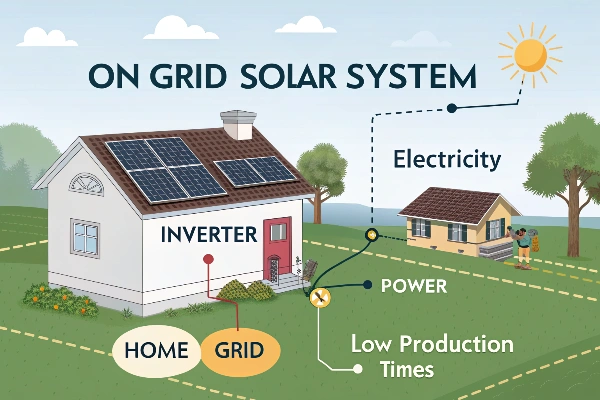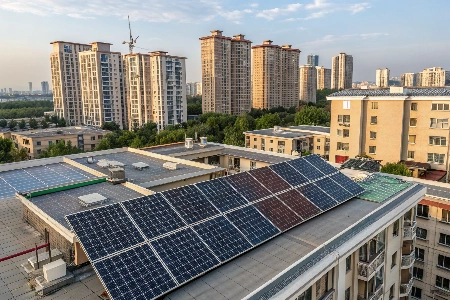On-Grid Home Solar System in India
Smart, Affordable, and Sustainable Rooftop Power for Modern Homes
Electricity costs in India continue to rise, but the sun gives you free power every day. With an On-Grid Home Solar System, you can generate your own clean energy, reduce monthly electricity bills, and even earn credit for excess power exported back to the grid.At Synergy Solar Solutions, we provide turnkey on-grid solar installations — from design and subsidy registration to commissioning and maintenance — ensuring a smooth and profitable solar journey for every homeowner.

What Is an On-Grid Home Solar System?
An On-Grid Solar System (also known as a Grid-Tied Solar Power System) is a solar setup directly linked to the electric utility grid. It generates power using solar PV panels and supplies it to your home. When production exceeds your consumption, surplus energy is sent back to the grid through net metering.Unlike off-grid or hybrid systems, the on-grid system does not include batteries. It relies on the grid as a backup source during night or cloudy days — making it the most economical and maintenance-free solar solution for residential properties.
How Does an On-Grid Solar System Work?
A rooftop on-grid system is a smart interaction between your home, the sun, and the grid:
Solar Panels (Photovoltaic Modules)
Capture sunlight and convert it into DC (direct current) electricity.
Solar Inverter (Grid-Tie Inverter)
Converts the DC electricity into AC (alternating current) — the standard power format used in homes.
Net Meter (Bi-Directional Meter)
Records two-way energy flow — electricity drawn from the grid and excess energy exported back.
Grid Export & Import
- When solar power is more than your home usage → surplus is sent to the grid, and you earn energy credits.
- When usage exceeds generation (e.g., at night) → your home automatically uses grid power.
Safety Disconnect
In case of grid failure or maintenance, the inverter automatically shuts off to protect utility workers and your system.

Government Subsidy for Rooftop On-Grid Solar (2025)
India’s MNRE (Ministry of New & Renewable Energy) promotes residential solar adoption through rooftop subsidy programs under the National Portal for Rooftop Solar (NPRS).
Eligibility Conditions:
Installation must be on the rooftop of a residential building.
System size eligible for subsidy: Up to 3 kW only.
System must use MNRE-approved panels and inverters.
Installation should be done through a registered vendor/EPC like Synergy Solar Solutions.
| System Capacity | Typical Usage | Subsidy % | Approx. Subsidy (₹) | Remarks |
| 1 kW | Small 1BHK / lighting load | 40 % | ₹ 28 000 | Eligible |
| 2 kW | 2BHK / appliances | 40 % | ₹ 52 000 | Eligible |
| 3 kW | 3BHK home / A/C | 40 % | ₹ 72 000 | Maximum subsidy limit |
| 4 kW + | Villas / large homes | nil | ₹ 0 | No subsidy |
Synergy Solar handles everything — subsidy application, inspection, and reimbursement — through the National Portal process.
Advantages of On-Grid Solar Systems for Homes
Cost-Efficient
No expensive batteries, lower upfront cost.
Eco-Friendly
Reduces carbon footprint, helping India reach Net Zero goals.
Net Metering Savings
Earn energy credits for every surplus unit sent to the grid.
Grid Backup
Seamless power availability using grid energy during low-sunlight hours.
Simple Design
Fewer components = easy maintenance.
High ROI
Payback within 3–4 years and 25 + years of performance life.
Subsidy Benefits
Up to 40 % government subsidy for rooftop systems ≤ 3 kW.
Points to Consider Before Installing an On-Grid Solar System
Must have shadow-free roof space with south-facing exposure.
Stable grid connection is required for synchronization.
No power during grid outages (unless paired with hybrid backup).
Periodic cleaning of solar panels is necessary to maintain output.
Ensure MNRE-certified components to remain subsidy-eligible.
Applications of On-Grid Solar Systems in Residential Buildings

Independent Houses & Villas
Generate power for all your household appliances — fans, lights, refrigerators, air conditioners — and reduce monthly bills by up to 90 %.

Apartments & Housing Societies
Use shared rooftop systems to power lifts, water pumps, and common lighting areas through net-metering.

Rural & Semi-Urban Homes
Where grid access exists, on-grid solar provides reliable daytime power and dramatically lowers reliance on conventional energy.
Components of an On-Grid Solar Power System
- Solar PV Modules (Mono PERC / Bifacial)
- Grid-Tie Inverter
- Mounting Structure (Galvanized Steel / Aluminum)
- Net Meter
- DC Distribution Box & ACDB
- MC4 Connectors & Cables
- Lightning Arrester & Earthing Kit
Installation & Commissioning Process

Site Assessment & Feasibility Study

System Design & Load Analysis

Quotation & Subsidy Registration

Rooftop Structure & Panel Mounting

Wiring, Inverter & Net Meter Installation

Testing & Commissioning

Monitoring Setup & Maintenance Support
Why Choose Synergy Solar Solutions?
MNRE-approved EPC & Registered Vendor
Experienced Engineers with 500 + Residential Projects Delivered
Use of Tier-1 Panels & Branded Inverters (Waaree, Delta, Havells)
Trusted Across Tamil Nadu, Karnataka, Maharashtra, and beyond
End-to-End Documentation & Subsidy Assistance
Real-Time Energy Monitoring & AMC Options
Realistic Example – 3 kW On-Grid Rooftop System
| Parameter | Value |
| Monthly Generation | 360 – 400 units |
| Approx. Monthly Saving | ₹ 2 500 – ₹ 3 000 |
| Annual Saving | ₹ 30 000 – ₹ 36 000 |
| Payback Period | 3 – 4 years |
| System Life | 25 + years |
This makes it one of the smartest and most sustainable investments for Indian homeowners.
Frequently Asked Questions (FAQs) – On-Grid Home Solar System
1 What is an on-grid solar system for a home?
An on-grid solar system (also called a grid-tied solar system) is connected directly to your local electricity grid. It generates solar power during the day and supplies it to your home. When production exceeds consumption, the extra power is exported to the grid through net metering, earning you bill credits.
2 How does an on-grid solar system work at home?
Solar panels convert sunlight into DC power, which is converted into AC by a grid-tie inverter. This electricity powers your home, and surplus energy is exported to the utility grid. At night or during cloudy weather, your home draws power back from the grid automatically.
3 What is the cost of an on-grid home solar system in India?
The cost of an on-grid solar system starts around ₹70,000 – ₹80,000 per kW before subsidy. A 3 kW rooftop system typically costs ₹1.8 – ₹2 lakhs, but after the 40 % MNRE subsidy, the cost reduces to nearly ₹1.1 – ₹1.3 lakhs.
4 Is there any subsidy for on-grid solar systems?
- Yes, the Government of India offers subsidy only for rooftop on-grid solar systems up to 3 kW capacity under the National Portal for Rooftop Solar (NPRS).
- No subsidy is available for ground-mounted or systems above 3 kW (e.g., 4 kW and above).
5 How can I apply for the rooftop solar subsidy in India?
You can apply online through the National Portal for Rooftop Solar (https://solarrooftop.gov.in) by registering your details, selecting an MNRE-approved vendor like Synergy Solar Solutions, and uploading installation documents. Subsidy is transferred directly to your bank account after DISCOM inspection.
6 Does an on-grid solar system work during a power cut?
No. When the utility grid fails, your on-grid system automatically shuts down for safety reasons (to prevent back-feeding). It will resume operation once the grid power is restored.
7 What are the advantages of an on-grid home solar system?
- Most cost-effective solar solution
- No batteries required (low maintenance)
- Earn savings via net metering credits
- Government subsidy up to 3 kW rooftop
- Long system life of 25 + years
8 What size of on-grid solar system is ideal for a home?
Typical residential systems range from 2 kW to 5 kW depending on your monthly electricity usage:
- 2 kW for small homes (₹2 – 3 k savings/month)
- 3 kW for medium homes (₹3 – 4 k savings/month)
- 5 kW for large villas (₹5 – 6 k savings/month)
Subsidy is limited to the first 3 kW capacity only.
9 What is net metering and how does it benefit homeowners?
Net metering allows you to export unused solar electricity to the grid. The DISCOM records your import/export data via a bi-directional meter. Surplus units are credited in your electricity bill, significantly lowering monthly expenses.
10 What is the lifespan and maintenance required for an on-grid solar system?
A good-quality on-grid solar system lasts 25 + years. Maintenance involves only cleaning the panels every 10–15 days and periodic electrical checks. Synergy Solar Solutions offers AMC packages for long-term performance assurance.
11 Can I add batteries to my on-grid solar system later?
Yes, you can upgrade your existing on-grid setup to a hybrid solar system by integrating compatible batteries and hybrid inverters. This enables backup power during grid outages if required.
12 Which inverter is best for on-grid home solar systems?
Leading brands include Waaree, Delta, Havells, and Sungrow, known for efficiency, safety, and compatibility with MNRE guidelines. Synergy Solar Solutions recommends inverter selection based on your load and roof size.
13 What documents are needed for rooftop solar subsidy approval?
- Property proof / electricity bill
- Aadhar + PAN card
- Installation report from MNRE-registered vendor
- Net-metering agreement with DISCOM
14 How much can I save monthly with a 3 kW on-grid solar system?
A 3 kW system can generate around 360 – 400 units/month, saving roughly ₹2,500 – ₹3,000 per month depending on your tariff and location.
15 Why should I choose Synergy Solar Solutions for my on-grid system?
Because Synergy Solar Solutions is an MNRE-approved EPC contractor providing end-to-end rooftop solar installation, subsidy documentation, net-metering assistance, and after-sales support — ensuring reliability, performance, and peace of mind
